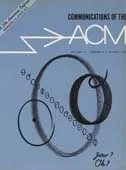August 1967 - Vol. 10 No. 8

Features
A computer technique for displaying n-dimensional hyperobjects
A digital computer and automatic plotter have been used to generate three-dimensional stereoscopic movies of the three-dimensional parallel and perspective projections of four-dimensional hyperobjects rotating in four-dimensional space. The observed projections and their motions were a direct extension of three-dimensional experience, but no profound "feeling" or insight into the fourth spatial dimension was obtained. The technique can be generalized to n-dimensions and applied to any n-dimensional hyperobject or hypersurface.
Contextual understanding by computers
A further development of a computer program (ELIZA) capable of conversing in natural language is discussed. The importance of context to both human and machine understanding is stressed. It is argued that the adequacy of the level of understanding achieved in a particular conversation depends on the purpose of that conversation, and that absolute understanding on the part of either humans or machines is impossible.
0
The most fundamental underlying problem in sophisticated software systems involving elaborate, changing data structure is dynamic storage allocation for flexible problem modeling. The Free Storage Package of the AED-1 Compiler System allows blocks of available storage to be obtained and returned for reuse. The total available space is partitioned into a hierarchy of free storage zones, each of which has its own characteristics. Blocks may be of any size, and special provisions allow efficient handling of selected sizes, control of shattering and garbage collection, and sharing of physical space between zones. The routines of the package perform high level functions automatically, but also allow access and control of fine internal details as well.
On compiling algorithms for arithmetic expressions
This paper deals with algorithms concerning arithmetic expressions used in a FORTRAN IV compiler for a HITAC-5020 computer having n accumulators. The algorithms generate an object code which minimizes the frequency of storing and recovering the partial results of the arithmetic expressions in cases where there are several accumulators.
A comparison of batch processing and instant turnaround
A study of the programming efforts of students in an introductory programming course is presented and the effects of having instant turnaround (a few minutes) as opposed to conventional batch processing with turnaround times of a few hours are examined. Among the items compared are the number of computer runs per trip to the computation center, program preparation time, keypunching time, debugging time, number of runs, and elapsed time from the first run to the last run on each problem. Even though the results are influenced by the fact that “bonus points” were given for completion of a programming problem in less than a specified number of runs, there is evidence to support “Instant” over “Batch”.
An efficient machine-independent procedure for garbage collection in various list structures
A method for returning registers to the free list is an essential part of any list processing system. In this paper, past solutions of the recovery problem are reviewed and compared. A new algorithm is presented which offers significant advantages of speed and storage utilization. The routine for implementing this algorithm can be written in the list language with which it is to be used, thus insuring a degree of machine independence. Finally, the application of the algorithm to a number of different list structures appearing in the literature is indicated.
Reduction in the size of decision tables can be accomplished by several techniques. The techniques considered in this paper are on the parsing of decision tables with regard to horizontal and vertical data structures, job identity, hardware and job priorities, and context relationships. Such parsing rests upon some conventions for the linkage of decision tables.
The Chairman of the ACM Standards Committee, Julien Green, has charged me with making “more effective use of CACM for communication … to get grass-roots opinions from the ACM membership.” This paper is the first attempt.
A partial dossier on distinguishing between handwritten zero and the letter oh is assembled here. This presentation was triggered by a request for guidance in this matter presented by the United Kingdom Delegation to ISO/TC97/SC2, Character Sets and Coding, at the meeting in Paris on 1967 March 13-16. The matter is just now in the province of USASI X3.6, to which comments might be directed.
Comments will be expected within sixty days [by approximately October 1st].
ARPA: a visible means of support
The Advanced Research Projects Agency has probably done more to lift computer science from other disciplines and to put it on its own feet than any organization inside or outside of government. Even today, when support of computing is spread throughout the government, ARPA is practically alone in its belief that computing deserves to be a separate discipline. Ironically, the computer profession knows little about this friendly benefactor.



